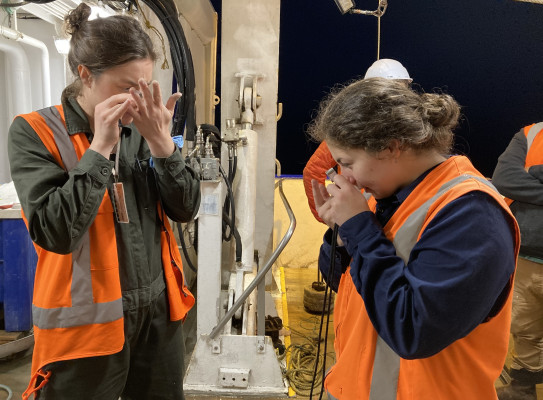Unearthing the volcanic past of Tūhua and Whakaari using marine sediment cores

Both Tūhua and Whakaari show evidence of explosive activity, but current understanding of their eruptive behaviour is often limited by what we see on land. Through the Beneath the Waves programme, we are accessing the record of past eruptions that’s preserved in the sediment layers of the seafloor.
Explosive eruptions often eject material into the atmosphere by means of a buoyant cloud that expands outwards as the ejecta precipitate out and form tephra deposits away from source. Given that Whakaari and Tūhua are surrounded by water, most of their volcanic ash deposits onto the ocean floor. This means that the marine sediment preserves a record of ash-producing events within the mud. The layers also host a variety of carbonate shells that can be used for radiocarbon dating to determine the age of the observed tephra (volcanic ash) layers .
Our team collected 37 marine sediment cores from around Whakaari and Tūhua on a research voyage in October 2023. (Read the voyage summary(external link) to learn more about how they achieved this feat). This article provides an update on the processing and analysis that has occurred since the cores were collected, and what we are doing with the data.
A portable 40 ft container on the vessel served as an onboard core processing facility. Onboard the cores underwent magnetic susceptibility measurements at 2 cm intervals. Magnetic susceptibility is the ability of a material to magnetise when a known magnetic field is applied. Volcanic ash often contains abundant magnetic elements (e.g., Fe, Ni, and Co) in the form of minerals like haematite and biotite. As a result, tephra deposits (i.e., ash) produce spikes in magnetic susceptibility measurements when compared to those of the surrounding mud, thus allowing scientists to identify the presence of potential tephra layers before the core’s interior is even exposed.

After magnetic scanning, the cores were split into archive (for reference) and working halves (for logging and sampling) to be cleaned up, photographed, logged manually, and sampled.
Watch this video of sampling tephra units from one of the split cores at GNS Science. Credit: Brenda Ferguson.
Watch this video of the core being split in the plastic core liner using a Geotek Core Splitter
We have identified around 360 visible tephra layers and collected 563 tephra samples from the 105 metres of core material retrieved during the voyage. These ash samples are currently being prepared for chemical analysis to provide insights into the chemical composition of the erupted magma. Subsequently, just like a human fingerprint is unique to an individual, the data obtained from these chemical analyses can help us identify the source volcano and unravel the eruptive histories of the two volcanoes.
In the samples, along with ash from these two volcanoes, we also see distinct well-known layers from the central North Island volcanoes that have produced very large eruptions in the past. For example, white ash layers from Taupō and Ōkataina volcanoes provide excellent marker horizons in the cores that can be used as time markers from eruptions such as the 230 AD Taupō eruption and the 1314 AD Kaharoa eruption.


High-resolution imagery (e.g., CT scanning and spectrophotometry) and non-destructive chemical analyses (e.g., X-Ray core scanning) are being carried out on the archive halves of the cores. The objective is to ensure more complete explosive eruptive histories for Tūhua and Whakaari by also identifying and recording very thin ash layers that cannot be observed with the naked eye (i.e., micro- or crypto-tephra).
The collected marine sediment cores are also useful in determining the timeframe within which the observed erupted events have occurred. Radiocarbon dating of individual macroscopic shells and hand-picked microscopic foraminifera shell communities within sediment samples can help date the marine mud above and below the ash deposits, thus allowing us to establish the frequency-magnitude relationship of the two volcanoes.
This research will inform us of the potential ashfall hazards from future Whakaari and Tūhua eruptions and calculate the probability of hazard occurrence for North Island regions, such as the Bay of Plenty, Waikato, and Auckland coastal communities.
Thanks to all those who have been involved in this project thus far:
- Coring team aboard the RV Tangaroa: Dr. Simon Barker (VUW), Jacqueline Grech Licari (VUW PhD student), Pip Tildesley (VUW PhD student), Jenny Stein (Communications Coordinator, GNS Science), Erica Spain (Coring Technician, NIWA)
- Additional core processing at GNS Science: Jacqueline Grech Licari (VUW PhD student), Brenda Ferguson and David Hobbis (VUW BSc students), Keiha Nicol (VUW MSc student) and Lizette Reyes (Core Processing Lab Tech, GNS Science).
